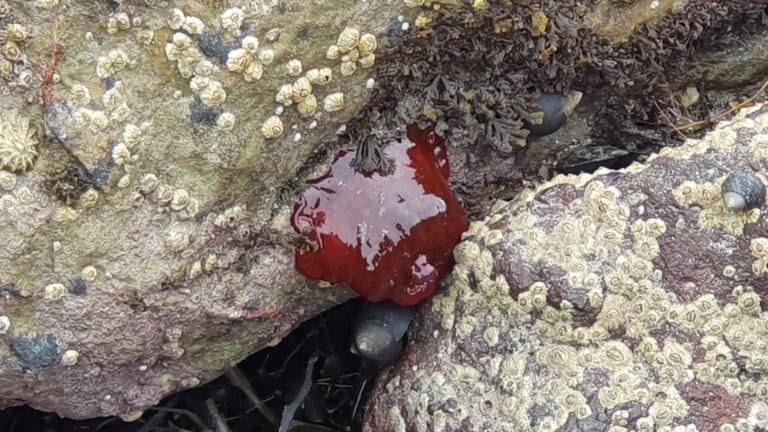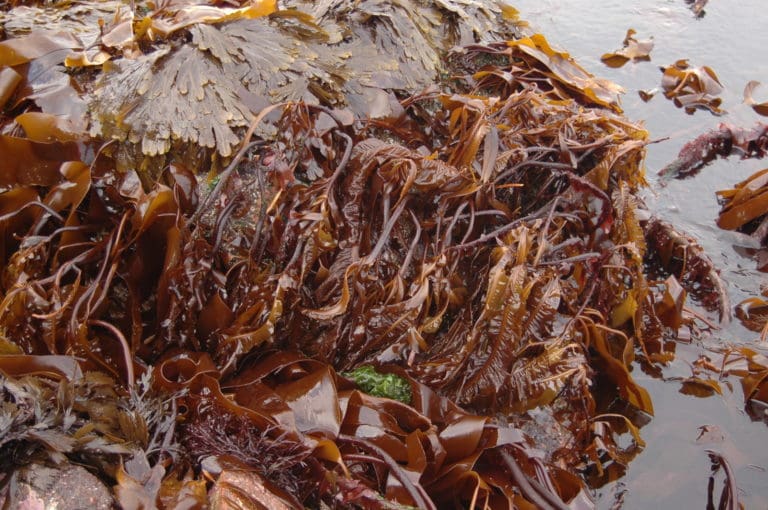



Studies of the rocky shore in Sullom Voe and Yell Sound have been carried out annually since 1976. The abundance of selected plant and animal species are surveyed at various sites along transects on the intertidal shore.
Annual rocky shore monitoring was launched in 1974 and is one of the longest running ecological datasets in the industry.
The sites surveyed along the shore vary according to exposure to wave action. The same sites are re-surveyed annually to map changes as a result of the construction of the terminal. The survey mostly focuses on species abundance and this is compared to previous data.
The latest survey conducted in 2020 showed very little change in species abundance since 2019 and any changes that were detected have been attributed to natural fluctuations. It was concluded that the current rocky shore communities are in good health, with no detected effects of terminal activities at the transect sites.
Comparisons of recorded abundances, field notes and photographs from the 2020 survey with those from the 2019 survey and previous surveys have been carried out.
Rocky shore communities at the twenty-four sites in 2020 were generally similar to those surveyed in 2019.
The most noteworthy features of interest are listed below:
• A notable settlement of juvenile keel worms Spirobranchus was seen at sites in Sullom Voe. Long term data suggests a possible trend of increasing abundance of these worms.
• Abundances of the barnacle Semibalanus balanoides were well within the normal range of fluctuations, but barnacle spat were relatively sparse.
• Limpet, Patella vulgata, densities were also very similar to 2019, though juveniles were less abundant. Increases at Jetty 2 transect suggest that shore has stabilised after disturbances from the physical rearrangement of boulders in 2016.
• Average abundance of edible winkles Littorina littorea fell in Sullom Voe in 2020, but not at the reference sites. The reduction was due mainly to fewer records at marginal stations. It is considered likely that this is a natural fluctuation.
• A continued decline in the abundance of rough winkles Littorina saxatilis is apparent.
• Percentage cover of mussels Mytilus edulis was relatively low in 2020 and data suggest there may be downward trend in their abundance over the last few years.
• Abundance of the red alga Dumontia contorta had markedly declined since the start of the programme and was very low in 2009, but records and percentage cover have started to increase again in recent years.
• There was a surprisingly large increase in percentage cover of encrusting coralline algae in 2020, due to moderate increases at many sites and stations.
• Numbers of records of the filamentous brown alga Elachista fucicola in Sullom Voe were the highest ever recorded in 2020.
• Abundance of knotted wrack Ascophyllum nodosum increased at reference sites in 2020 but was stable within Sullom Voe.
• There was a further increase in the average abundance of bladder wrack Fucus vesiculosus and in 2020, across the Sullom Voe sites, it was higher than in any previous year.
• Abundance of green algae remained relatively low, compared to the early 2000s, but there were modest increases in Ulva and Cladophora.
SOTEAG’s rocky shore data set is one of the longest running and most valuable of its type in the UK. In 2001, the Marclim Project was given access to the data to help in their investigation of the effects of climate change on marine biodiversity. Using historic time series data and contemporary data, the project used key intertidal species whose abundance had been shown to fluctuate with changes in climatic conditions, as indicators of change in intertidal and offshore zones.
Dog whelks are an intertidal snail found on rocky shores. They have been monitored biennially since 1991 as a part of the rocky shore programme, to monitor the long term impacts of Tributyl-Tin (TBT) stemming from anti-foutling paints used on supertankers at the Terminal’s jetties.
Surveys carried out by the Scottish Office Agriculture, Environment and Fisheries Department (SOAEFD) in 1988 and 1990 showed a significant decline of dog whelk populations in Sullom Voe and near Yell Sound. The decline has been attributed to the use of TBT, which causes female dog whelks to develop male sexual characteristics, therefore preventing reproduction of the species. SOTEAG surveys have been used to determine the geographical spread of the effects of TBT, arising from oil tanks approaching and leaving the terminal.
The use of TBT as an anti-foulant has gradually become restricted since the mid-1980s, including an international ban preventing its use entirely that came into force in September 2008. Monitoring continues in order to assess signs and rates of recovery in the dog whelk population, as the species gradually recolonize the shores.
Results of the present survey were compared to the previous imposex surveys (1987 to 2015) and assessed against the Oslo and Paris Commission (OSPAR) assessment criteria.
The degree of imposex (RPSI and VDSI measurements) in adult and juvenile dogwhelks from sites within Sullom Voe in 2018 show that these sites continue to be more impacted by tri-butyl tin (TBT) than populations at sites in Yell Sound, but that this difference is no longer statistically significant.
As TBT inputs to the Voe have ceased following the International Maritime Organisation (IMO) ban on use on large vessels in 2008, the continued development of imposex in juveniles is likely due to reservoirs of residual concentrations in sub-tidal sediments that are known to be present in the area of the terminal.
As in previous surveys, the degree of imposex in populations in Yell Sound tends to decrease with distance from Sullom Voe.
No sterile female dogwhelks were recorded from any site and the presence of juveniles and eggs at all sites confirmed that all populations had the capacity to reproduce.
RPSI and VDSI levels decreased at most sites, but six sites showed a small increase in levels. None of those increases was considered notable and they likely represent inherent variability rather than a change in environmental conditions.
RPSI levels at all sites remained close to zero with no substantial changes.
Changes in VDSI resulted in changes in OSPAR Classification for four sites, all of which are now classified as A or B, which means that all are below the Environmental Assessment Criteria (EAC).
Please click here to view the rocky shore monitoring reports.






